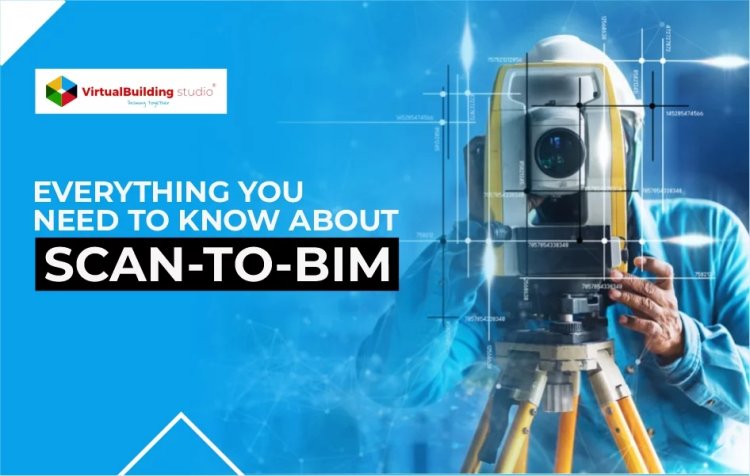Everything You Need to Know About Scan to BIM
Let’ s explore more on scan to BIM services and understand the process that goes behind it.
Share this Post to earn Money ( Upto ₹100 per 1000 Views )

You’re probably well-versed with the term BIM and how it constructs a virtual model of your design to create a detailed process that maps every stage from design to execution. The advancement in technology has introduced another working technique to convert an existing structure into a precise virtual model Scan to BIM.
Let’ s explore more on scan to BIM services and understand the process that goes behind it.
What is Scan to BIM?
As designers have mastered the art of model making using BIM, the next breakthrough had to be the as-built models for existing structures. Laser scanning in construction enables the capturing and scanning in 3D of existing projects.
The information gathered by the scanners is then used to construct a virtual model of the same. This digitized data can then be used for monitoring or redevelopment of the project.
Why is Laser Scanning in Construction Important?
Scan to BIM services has a potential for growth in the AEC industry owing to the ease of design and operation it offers. Laser scanning promises reliability with precise capturing of points. A virtual as-built model aids in the assessment of the structure and accelerates the decision-making process as each iteration can be applied and the impact can be assessed.
A scanned model can minimize the costs for rework of errors on-site as the entire process is transparent amongst collaborators and the model enables coordination amongst members of different teams.
With rapid transformations in the global building and design sector, there a revolution in construction methods as well with scanning services being amongst the most fruitful ones.
How does the process of Scan to BIM work?
It makes use of a 3D laser scanner where the beam from it strikes the surface and acquires point clouds. Then the data undergoes the process of converting this point cloud to BIM.
Here is a step-by-step guide to understanding the function better:
- As you’ve got all the data from the 3D laser scanner, open the designated software to load the point cloud into the project.
- The next step for conversion of point cloud to BIM involves translating the data into another file format.
- Then comes the indexing process in which scanned data is taken up and added as a cloud file.
- Link this data with the project in the .rcp or .rcs format.
- Load the data file on the Revit project with the Point cloud tool and position it by picking the most appropriate option among the three displayed ones.
- Once the file has been positioned, link the point clouds by clicking open.
Problems solved using Laser Scanning in the Construction Process
The main motive of laser scanning in construction is to capture reality and upload it to digital space. The areas catered to by it in design and construction are as follows:
Generating Design Solutions
An efficient design is all about a design proposal that not only produces great structures but also caters to the site conditions. Scanning services capture the exact site conditions that result in better design decisions with a deeper understanding of context.
Smooth Construction Phase
The as-built and as-designed information presented in the virtual model aids in tallying process and clash-detection at the design stages. The feature of virtual installation helps in the identification of any discrepancies that could come up while executing on-site.
A Safe and Sound Design
The rate of construction hazards can be reduced by adopting these services. The early-stage depiction of potential hazards and proposals for construction safety measures promise a safe workflow.
Building Analysis
Point cloud to BIM facilitates a building operation analysis. From structural evaluation to accessibility examination, each aspect of the project can be studied to propose better and more reliable solutions.
A Time-Saver Approach
One of the major challenges faced in the construction industry is delays in the timeline. With the incorporation of laser scanning, the virtual model lets you go through each aspect of design in detail which eliminates the need for frequent site visits. The clash-detection and early design phase also rule down the need for rework on-site, saving time, resources, and efforts.
What is the importance or advantages of scan to BIM?
- The work generated with laser scanning and BIM has an unmatched quality with precision in detailing and efficiency in the layouts.
- The easy coordination amongst all the stakeholders and designers saves time by eliminating the need for one team work to be completed to be taken forward by another team. With a single point source, all teams can work simultaneously and stay updated on the project.
- A virtual model with intricate details and layouts aids in quick design decisions and alterations can be assessed on the model itself.
- BIM promises a better future not only for the building users but for the environment as well. It can help you evaluate energy efficiency and opt for a sustainable path.
- Traditional construction methods have always proven to be costly due to the site reworks it demands. Laser scanning has helped to cut down project costs by offering a resolved set of drawings that ensures smooth functioning on-site.















